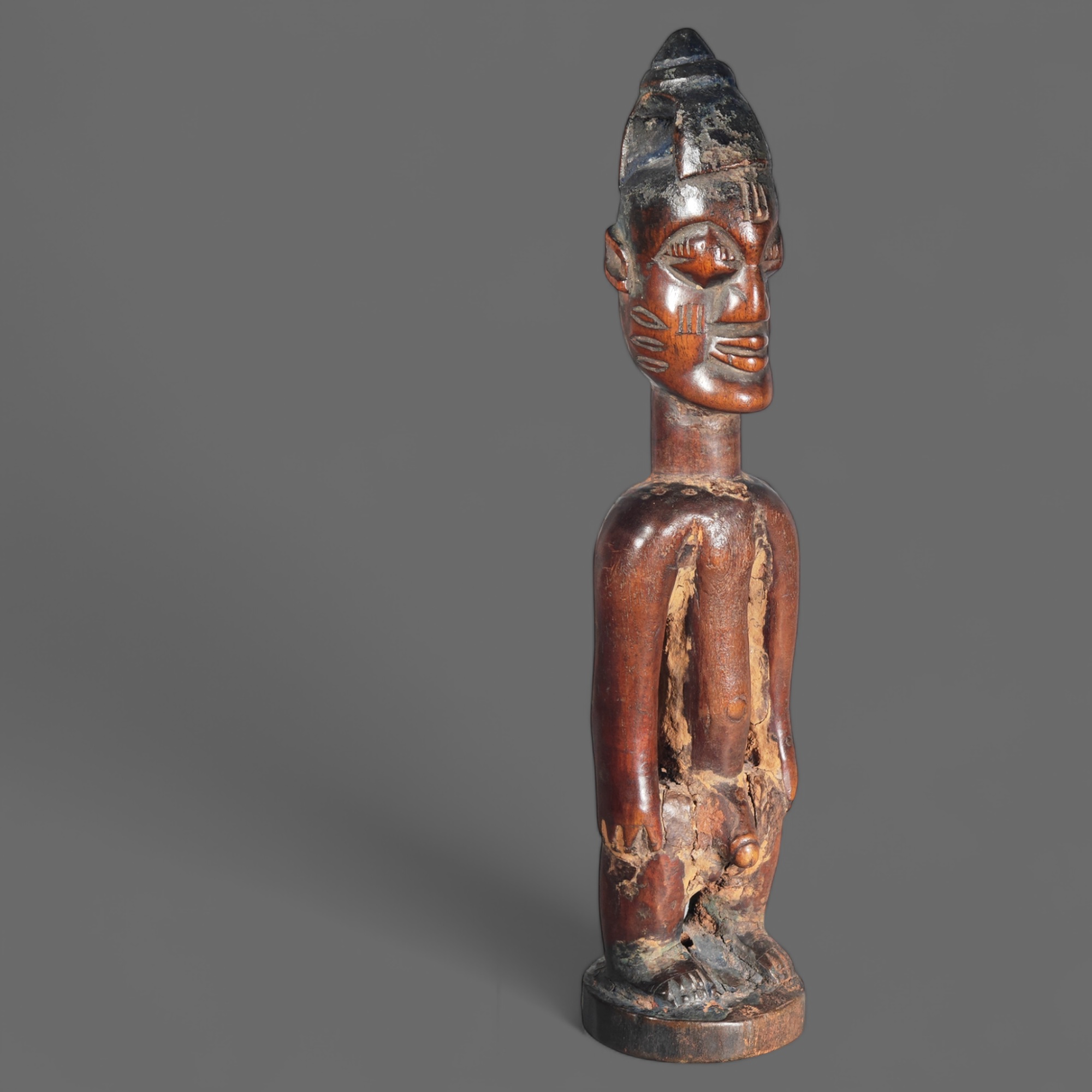
Ibeji Ilorin
Kwara State - 27,5cm
Parmi les productions artistiques des Yoruba, les Ibeji de l'État de Kwara, en particulier ceux du village d'Ilorin, occupent une place privilégiée dans mon appréciation. Leur diversité, presque infinie, témoigne d'une inventivité sans cesse renouvelée, tandis que leur puissance sculpturale impose une présence saisissante.
Je vous invite à découvrir un exemple exceptionnel avec cette effigie magistrale, dédiée au culte des jumeaux chez les Yoruba. Par sa taille imposante et son ancienneté remarquable, cette pièce se distingue parmi les œuvres comparables. La patine épaisse et profonde, rehaussée d'une brillance subtile sur les zones les plus touchées par le contact, confère à cet Ibeji un charme irrésistible.
Cette sculpture appartient à un corpus très restreint de 4 à 5 Ibeji connus, attribués à cet atelier ou à cette main spécifique. Son ancienneté est incontestable, remontant au moins à la fin du XIXᵉ siècle. De surcroît, elle provient d'une prestigieuse collection danoise, reconnue pour la qualité et la rareté de ses pièces.
Je serai heureux de vous fournir des informations détaillées sur sa provenance ainsi que des photographies en haute définition sous plusieurs angles, disponibles sur simple demande. Cet Ibeji constitue indéniablement une pièce incontournable pour tout collectionneur averti et passionné par l'art Yoruba.
Among the artistic creations of the Yoruba, the Ibeji from Kwara State, particularly those from the village of Ilorin, hold a special place in my admiration. Their nearly infinite diversity reflects an unceasing creativity, while their sculptural power commands a striking presence.
I invite you to discover an exceptional example with this masterful effigy, dedicated to the Yoruba cult of twins. With its imposing size and remarkable antiquity, this piece stands out among comparable works. Its thick and deep patina, enhanced by a subtle sheen on the areas most touched by handling, lends this Ibeji an irresistible charm.
This sculpture belongs to a very limited corpus of 4 to 5 known Ibeji attributed to this specific workshop or artist. Its antiquity is indisputable, dating back at least to the late 19th century. Furthermore, it originates from a prestigious Danish collection, celebrated for the quality and rarity of its pieces.
I would be delighted to provide detailed information about its provenance, as well as high-definition photographs from multiple angles, upon request. This Ibeji is undeniably a must-have for any discerning collector passionate about Yoruba art.
Ní àárín àwọn iṣẹ́ ọ̀nà àwọn Yorùbá, àwọn Ibeji láti Ìpínlẹ̀ Kwara, pàápàá ní ìlú Ìlọrin, ní ipò pàtàkì nínú ìfẹ́ tí mo ní sí wọn. Oríṣiríṣi wọn, tó jẹ́ nífà, ń fihan ìmòye àṣà àti ẹ̀dá ìwà tó ṣì ń gbèrú, nígbà tí agbára wọn nípa iṣẹ́ ìyàwòrán ń fi ìjòkó lé iṣẹ́ ọ̀nà wọn.
Mo gbà yín nímọ̀ràn láti ṣàwárí àpẹẹrẹ àgbàyé pẹ̀lú ìrírí yìí, èyí tó jẹ́ àwòrán ìbẹ̀rẹ̀ tó yẹ fún ìsin àwọn ìbejì láàárín àwọn Yorùbá. Pẹ̀lú ipò rẹ̀ tó ń dọ́gbà àti ìgbà tó ń tó jìnnà, iṣẹ́ ọwọ́ yìí wà lókè lọ nínú àwọn ohun tó le ṣe afiwé. Patina rẹ̀ tó ṣòfò yíká, pẹ̀lú ìmìlẹ̀ tó ń farahàn ní àwọn ibi tí wọ́n fi ọwọ́ pa jù lọ, ń fi ẹwà àrà lópin kún Ibeji yìí.
Àwòrán yìí jẹ́ ọmọ ẹgbẹ̀ kan nínú àwọn iṣẹ́ ìyàwòrán mẹ́rin tàbí márùn-ún, tí wọ́n ti mọ̀ nínú àwọn ilé iṣẹ́ tàbí ọwọ́ onísè pàtàkì yìí. Àṣẹlẹ̀ rẹ̀ kò ṣe ètòjọ̀, tó ń pada sí ìgbà ìkẹyìn ọ̀rúndún kọkàndínlógún. Bákan náà, ó jẹ́ ọmọ ìkànsí tí wọ́n gbé kalẹ̀ láti àkójọ ilé ìkànsí kan tó gbajúmọ̀ ní Dáníshì, èyí tó jẹ́ olókìkí fún ìtóbi àti ṣọ̀wọ́n àwọn nkan tó wà nínú rẹ̀.
Mo máa fọkàn yín balẹ̀ fún ṣíṣe àlàyé nípa ìtàn rẹ̀ àti fún fífi àwọn àwòrán tó tayọ̀ lókè dígí ní àwọn ìkànsí lọ́kọ̀ọ̀kan rán yín ní ìbẹ̀rẹ̀ náà. Ibeji yìí jẹ́ ní tòótọ́ nkan pàtàkì tó yẹ fún gbogbo akojọpọ̀ tó ní ìfẹ́ àti ìmọ̀ nípa iṣẹ́ ọ̀nà Yorùbá.
